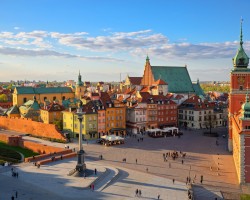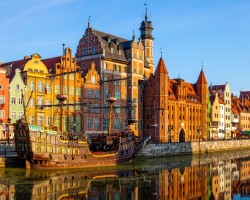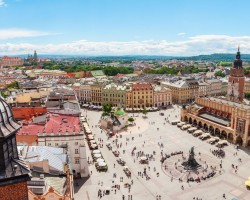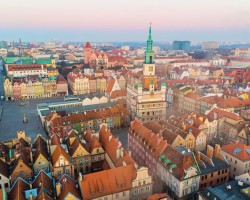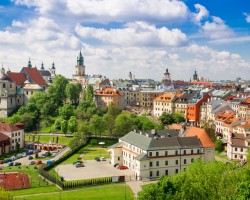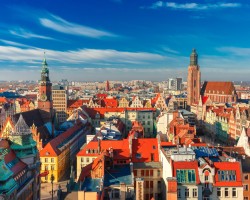Best time to go to Poland for a perfect weather and where to go?
When is the best time to go to Poland?
The best time to visit Poland is from May to September, when the temperatures allow you to make the most of all the advantages this country has to offer.
A Central European state, bordering Germany, the Czech Republic, Slovakia, Ukraine, Belarus, and Lithuania, Poland is a country with many facets. It will allow you to take a refreshing trip that combines culture in the stunning cities, trips in the great outdoors, between mountains and countryside, and even swimming in the Baltic Sea.
When to go to Poland based on your desires?
- The country primarily attracts fans of who walk in the footsteps of deportees at Auschwitz-Birkenau or other former Nazi camps. Of course, a visit during the summer season will soften the shock felt, but it is possible to go there year-round.
- To discover the stunning Polish cities like Warsaw, Krakow, Poznan, or Lublin, the best time can range from mid-April to early November. You will need to prepare warm and waterproof clothing to cope with all weather conditions.
- For a road trip through the Polish countryside, the best time to go is from May to early October. At the end of spring, the fields are adorned with multicolored flowers that are particularly photogenic, in summer you can enjoy spectacular hikes and swim in the multitude of lakes and rivers, while at the beginning of autumn, the trees display vibrant colors that offer an incredible spectacle of nature.
- To dive into the Baltic Sea, head to Gdansk, Poland's largest port. The region has very beautiful beaches, such as Jelitkowo for example. Prefer the months of July and August, when the water reaches comfortable temperatures: between 18 and 20°C (68°F) . The brave can attempt a swim in September, but you really have to be hardy.
- For winter sports, snow covers the country from the end of November and often until early April. The Zakopane region, located at the foot of the Tatra Mountains, attracts enthusiasts due to the beauty of its landscapes and postcard-worthy villages, as well as its excellent tourist offerings.
Where and when to go based on the weather?
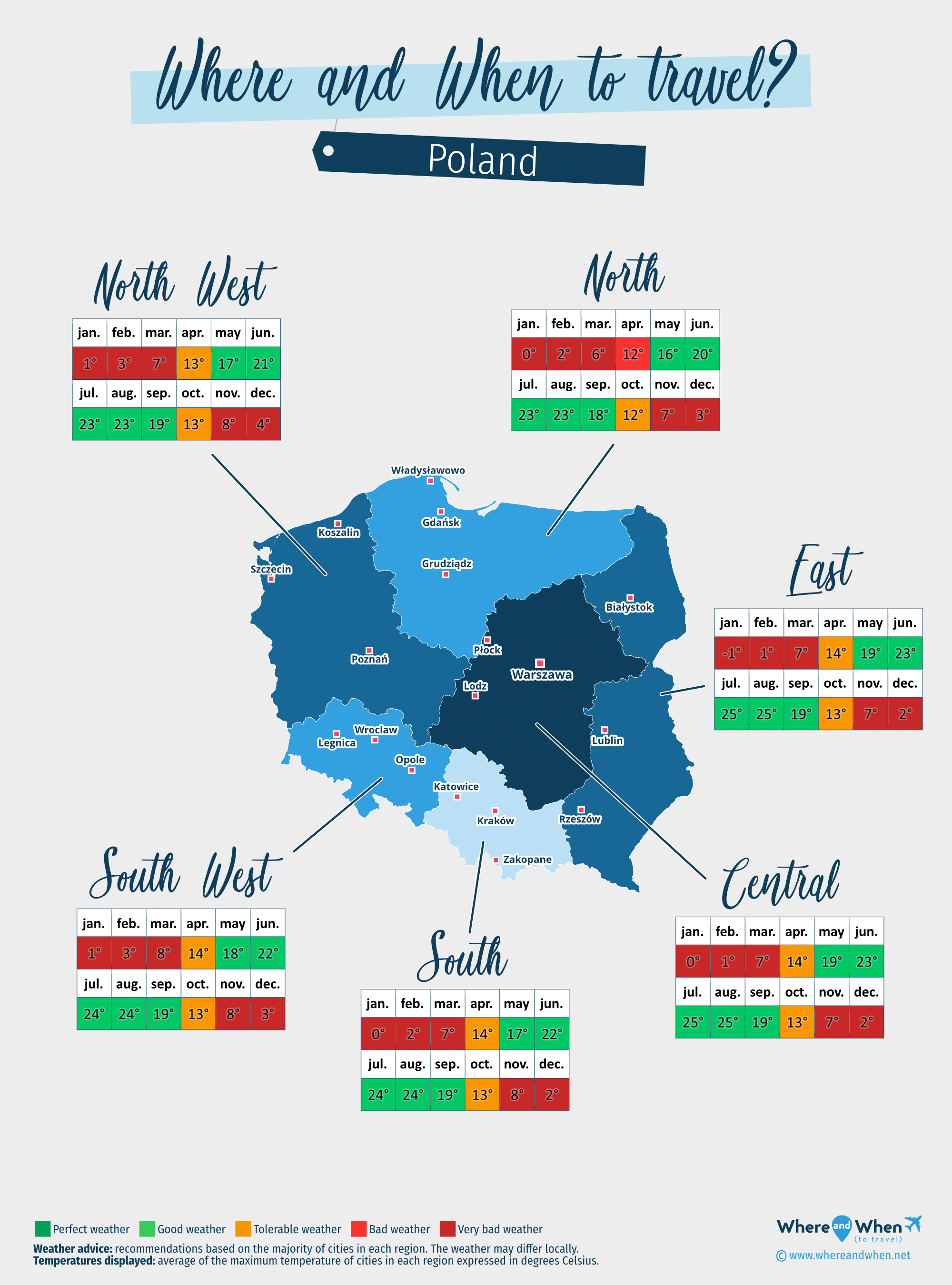
Central of Poland
Warsaw, Lodz, Płock...
East of Poland
Lublin, Rzeszów, Białystok...
North of Poland
Gdansk, Władysławowo, Grudziądz...
North West of Poland
Poznan, Koszalin, Szczecin...
South of Poland
Krakow (Cracow), Zakopane, Katowice...
South West of Poland
Wroclaw, Opole, Legnica...
To get all the information about the climate and weather in Poland for a specific month, click on the corresponding link below:
Poland in january Poland in february Poland in march Poland in april Poland in may Poland in june Poland in july Poland in august Poland in september Poland in october Poland in november Poland in december
Best time to travel to Poland by cities
Climate and Weather in Poland
The climate of Poland is predominantly of two types:
- An oceanic climate that is temperate is the most common, as it covers 75% of the territory. This is the type that prevails notably in the capital, Warsaw, in the Kraków region, in almost the entire northern part, and in most of the southern areas.
- A humid continental climate that is temperate and without a dry season is mainly found in the east and south of the country. It is particularly present in the mountains near Zakopane, in the Karkonosze National Park, and in the regions of Lublin, Mrągowo, and Ostrołęka.
Due to its geographical position in the center of Europe, the weather in Poland is influenced by three factors: the oceanic air masses from the west, the cold air masses coming from Russia, and finally, the warm and humid air masses arriving from the Mediterranean, along with the presence of the Carpathian mountain range in the south.
In general, rain falls year-round across Poland, with a lull during the winter, as it is mostly replaced by snowfall. Moreover, the seasons are very distinct, and the temperature variations are significant.
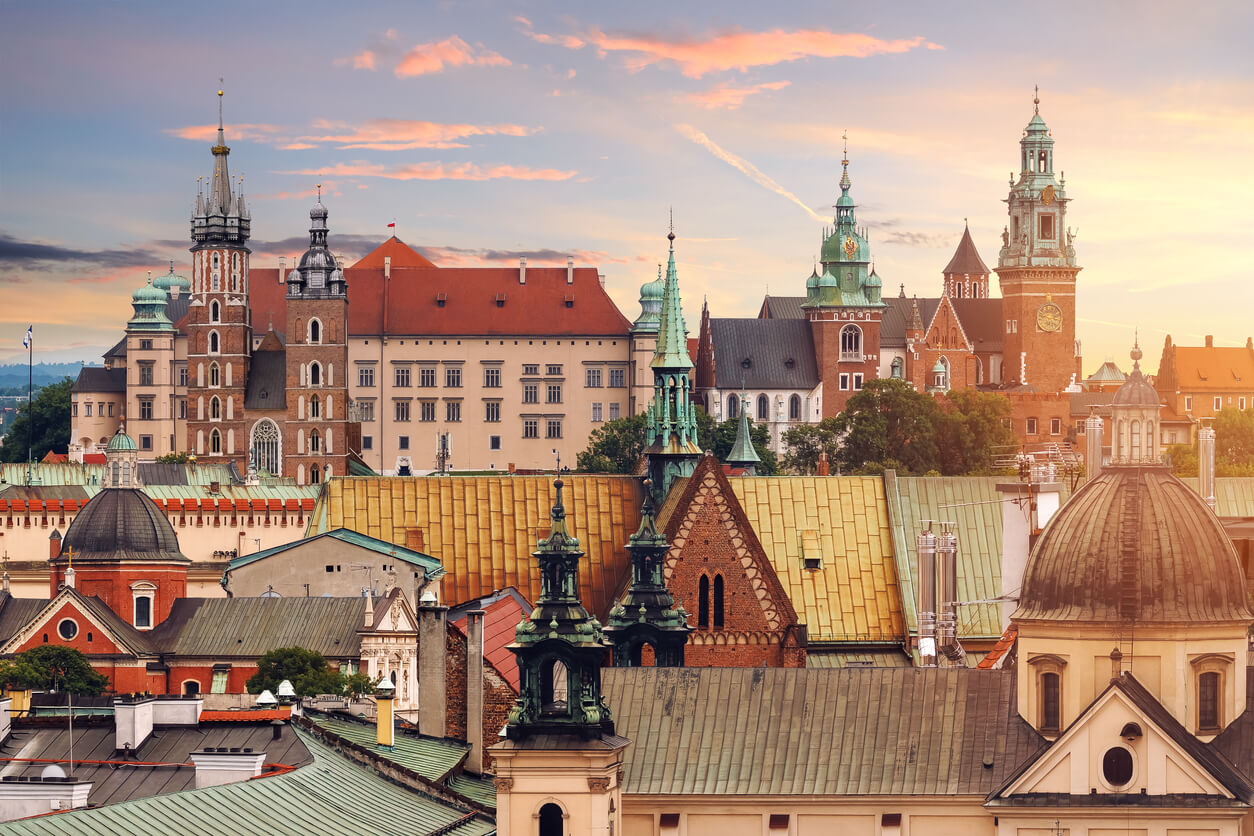
Climate of Poland in Winter
Winters, from December to March, are particularly cold in Poland and snow is very present. The coldest regions are in the east of the country, in the mountains and around Suwalki.
Until the end of February, the thermometer hovers around 0°C during the day and temperatures drop below freezing at night. However, extremes are very rare and, generally, the minimum temperatures do not fall below -5°C. The exception occurs when cold winds come from Russia, bringing with them freezing temperatures that can drop to -25°C.
Starting in March, the atmosphere begins to warm up: minimum temperatures are close to 5°C (41°F) and maximum temperatures reach 8 or 9°C (49°F) on average depending on the area.
Throughout the season, the sky is often gray and sunshine is low. It is safe to say that this is not the best time to travel to Poland, unless you are going skiing!
Climate of Poland in Spring
- From late March to late April, winter lingers in a large part of the country, with average temperatures between 6 and 14°C (58°F) , knowing that it is in the north and in the southern mountains that it is coldest during this period. Nevertheless, a trip remains feasible, as rainfall is quite low and the sun is more often present.
- In May, temperatures rise significantly: it is generally 16-17°C in the northern half and one to two degrees warmer in the south. Occasionally, the country experiences a return of frost in the middle of the month, but this phenomenon remains anecdotal and it is most often nice and mild.
- In June, the thermometer finally exceeds 20°C (68°F) everywhere and can even reach around 23°C (74°F) in the center and east of the country. It rains a little less than in May and the long days allow for full enjoyment of the country's beauties.
Climate of Poland in Summer
Summers are warm in Poland, but not scorching. From late June to late August, it is around 20°C (68°F) at night and daytime temperatures fluctuate between 25 and 30°C (86°F) depending on the regions. In September, the atmosphere begins to cool down and temperatures range from 17 to 21°C (70°F) .
However, it is the rainiest season of the year. This usually falls in the form of thunderstorms during the afternoons, especially in the mountains. Nevertheless, showers are most often short-lived and the sun quickly returns, offering visitors beautiful summer days.
Climate of Poland in Autumn
Autumn is often called "the golden season", as the weather is dry and particularly sunny from late September to late October. On the other hand, temperatures drop quickly and peak around 13°C (56°F) in October.
In November, winter seems to have already arrived: it is gray, the first snows come, and temperatures drop below 10°C (50°F) .
Temperatures and rainfall in Poland
On these 3 graphs, we present the evolution of temperatures of Poland and month-by-month rainfall for the cities of Warsaw, Gdansk, Krakow (Cracow), Poznan and Białystok, as well as the month-by-month sea temperature for coastal cities.
Peak visitor numbers and tourist seasons in Poland
Find out when Poland has its high tourist season (the period when the influx of tourists is highest) and off-peak tourist season using our data and figures.
Tourist seasons in Poland
The months with low numbers of tourists are: January, February, March, April, October, November and December. The number of visitors to Poland is high in: May, June, July, August and September.
- Very low season in Poland: January, February and March.
- Low season in Poland: April, October, November and December.
- High season in Poland: May, June and September.
- Peak season in Poland: July and August.
Figure: Visitor index for Poland month by month
Average price for flights to Poland
A return flight between New York City and Warsaw is generally cheaper if you go in february ($ 642 on average): this is the best time for travellers on a tight budget. In contrast, you may end up paying $ 581 more for your airline ticket to Warsaw if you go in july.
Where to go in Poland?
This table allows you to see the maximum temperature for each city and our opinion on the weather month by month (see colour legend below the table).
| Cities | jan. | feb. | mar. | apr. | may | jun. | jul. | aug. | sep. | oct. | nov. | dec. |
| Warsaw | 32°F | 36°F | 47°F | 59°F | 68°F | 76°F | 79°F | 79°F | 68°F | 56°F | 47°F | 38°F |
| Gdansk | 34°F | 36°F | 45°F | 54°F | 63°F | 70°F | 74°F | 74°F | 67°F | 56°F | 47°F | 40°F |
| Krakow (Cracow) | 34°F | 38°F | 47°F | 59°F | 67°F | 74°F | 77°F | 79°F | 70°F | 59°F | 49°F | 38°F |
| Poznan | 36°F | 38°F | 47°F | 59°F | 67°F | 76°F | 77°F | 79°F | 70°F | 58°F | 49°F | 40°F |
| Białystok | 31°F | 34°F | 43°F | 58°F | 67°F | 74°F | 77°F | 77°F | 67°F | 54°F | 45°F | 36°F |
| Grudziądz | 34°F | 36°F | 47°F | 59°F | 67°F | 74°F | 77°F | 77°F | 68°F | 56°F | 47°F | 38°F |
| Katowice | 34°F | 38°F | 47°F | 59°F | 67°F | 74°F | 77°F | 79°F | 68°F | 58°F | 49°F | 38°F |
| Koszalin | 36°F | 38°F | 45°F | 54°F | 61°F | 68°F | 72°F | 74°F | 67°F | 56°F | 47°F | 40°F |
| Legnica | 36°F | 40°F | 49°F | 61°F | 67°F | 74°F | 79°F | 79°F | 70°F | 59°F | 49°F | 40°F |
| Lodz | 34°F | 38°F | 47°F | 59°F | 67°F | 74°F | 77°F | 79°F | 68°F | 58°F | 47°F | 38°F |
| Lublin | 32°F | 36°F | 45°F | 59°F | 68°F | 76°F | 79°F | 79°F | 68°F | 56°F | 47°F | 36°F |
| Opole | 36°F | 40°F | 49°F | 61°F | 67°F | 76°F | 79°F | 79°F | 70°F | 59°F | 49°F | 40°F |
| Płock | 34°F | 36°F | 47°F | 59°F | 67°F | 74°F | 77°F | 77°F | 68°F | 58°F | 47°F | 38°F |
| Rzeszów | 32°F | 36°F | 47°F | 59°F | 68°F | 76°F | 79°F | 79°F | 70°F | 58°F | 49°F | 38°F |
| Szczecin | 36°F | 40°F | 49°F | 59°F | 67°F | 74°F | 77°F | 77°F | 68°F | 58°F | 49°F | 40°F |
| Wroclaw | 36°F | 40°F | 49°F | 61°F | 68°F | 76°F | 79°F | 81°F | 70°F | 59°F | 50°F | 41°F |
| Władysławowo | 34°F | 36°F | 43°F | 52°F | 61°F | 68°F | 72°F | 72°F | 65°F | 56°F | 47°F | 40°F |
| Zakopane | 31°F | 32°F | 40°F | 52°F | 59°F | 68°F | 70°F | 72°F | 63°F | 52°F | 45°F | 34°F |
| Augustów | 31°F | 32°F | 41°F | 56°F | 65°F | 72°F | 76°F | 76°F | 65°F | 54°F | 43°F | 34°F |
| Auschwitz | 34°F | 38°F | 47°F | 59°F | 67°F | 74°F | 77°F | 79°F | 70°F | 59°F | 49°F | 38°F |
Legend:
perfect weather
good weather
tolerable weather
bad weather
very bad weather
About Poland
What can I do in Poland?
Beaches / swimming
Nature and countryside
Culture and heritage
Sports
Family travel
Crafts / shopping
Gastronomy
Nightlife
Is this weather information for Poland reliable?
Climate data for Poland has been gathered every day since January 2009. The analysis of these meteorological data for Poland allows us to determine the average for each month in Warsaw, Gdansk, Krakow (Cracow), Poznan, Białystok, Grudziądz, Katowice, Koszalin, and 101 other cities.
So yes: this data is reliable except in cases of temporary climate disruption in the region.

